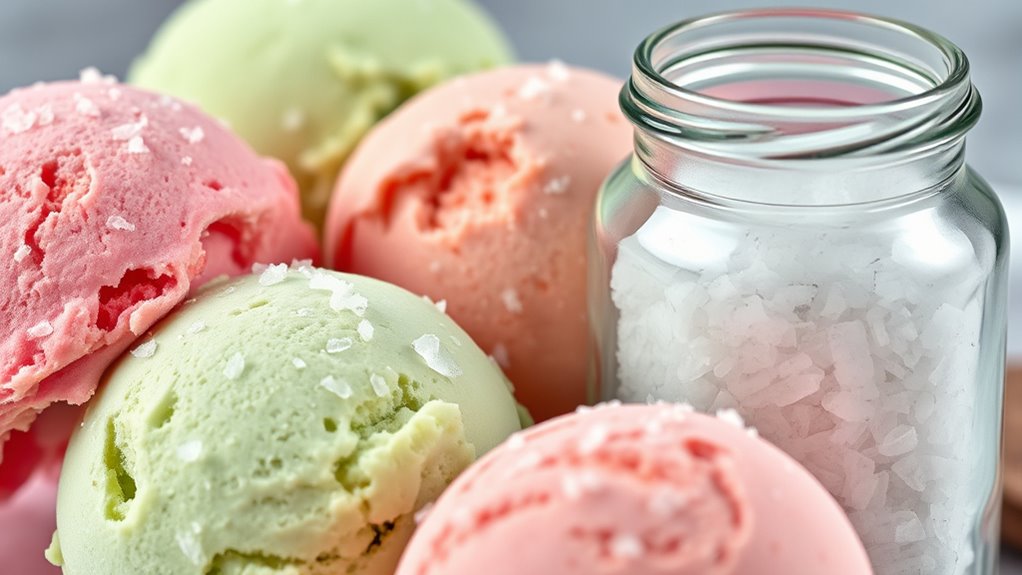Sodium levels in ice cream typically range from 50 mg to 58 mg per 1/2 cup serving. It’s important to check nutrition labels, especially if you’re managing health conditions like high blood pressure. While some brands may vary, keeping an eye on these numbers can help you enjoy your treat without compromising your health. Plus, you’ll discover tips for choosing lower-sodium options and healthier alternatives as you explore further.
Key Takeaways
- Ice cream typically contains sodium levels ranging from 50 mg to 57.6 mg per 1/2 cup serving, depending on flavor and brand.
- Monitoring sodium intake in ice cream is important for individuals with health concerns like high blood pressure.
- The recommended daily sodium limit is 2,300 mg, with an ideal target of 1,500 mg for optimal health.
- Many low-sodium ice cream options exist, including homemade treats and yogurt-based alternatives with less than 50 mg of sodium per serving.
- Natural flavors often have lower sodium levels compared to artificial ones, making them a better choice for health-conscious consumers.
Understanding Sodium in Ice Cream

When you dig into a bowl of ice cream, you mightn’t think about sodium, but it plays a key role in its nutritional profile. A typical 1/2 cup serving contains about 50 mg to 57.6 mg of sodium, varying by flavor.
Monitoring sodium levels is essential, especially for those with health concerns like high blood pressure. Different types of ice cream can have distinct sodium levels, impacting your overall intake.
If you love indulging in this treat, it’s wise to be aware of how much sodium’s sneaking into your diet. Consulting a healthcare provider can help you understand your sodium needs better and guide you in making informed choices regarding your ice cream consumption.
Enjoy, but stay mindful!
Nutritional Breakdown of Ice Cream
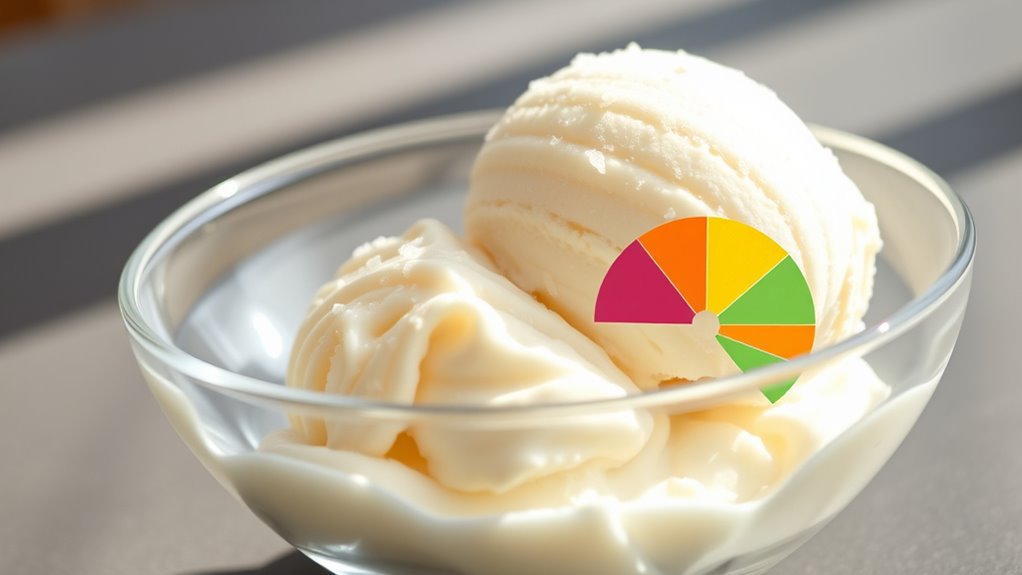
Ice cream isn’t just a sweet treat; it’s packed with a variety of nutrients that contribute to its overall appeal. A typical 1/2 cup serving contains essential nutrients alongside sodium, which plays a role in flavor.
| Nutrient | Amount per Serving |
|---|---|
| Sodium | 50-58 mg |
| Calories | 134-144 |
| Total Fat | 7-8 g |
| Sugar | 14.83-21 g |
You’ll also find about 46% carbohydrates, 48% fat, and 7% protein. Plus, it offers calcium, potassium, and vitamin A, making it more than just a delicious indulgence. So, next time you enjoy a scoop, remember it’s not just about the sweetness!
The Impact of Sodium on Health
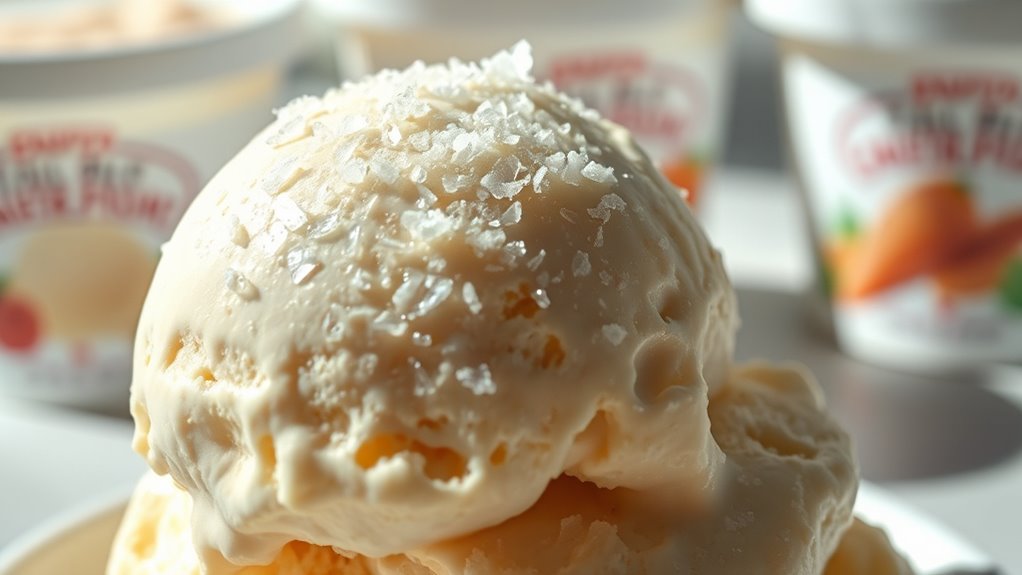
Sodium plays an essential role in regulating blood pressure, but too much can lead to serious health issues.
You need to keep track of your sodium intake, especially when enjoying treats like ice cream.
Let’s explore recommended limits and consider some tasty ice cream alternatives that can help you stay within those guidelines.
Sodium and Blood Pressure
Excessive sodium intake is a significant concern for maintaining healthy blood pressure levels. High sodium can lead to increased blood pressure, heightening your risk of cardiovascular diseases.
If you’re managing hypertension, it’s essential to track your sodium consumption, including sources like ice cream.
- Elevated blood pressure can feel overwhelming and isolating.
- Each scoop of ice cream can add up, impacting your daily diet.
- A small reduction in sodium can lead to significant health improvements.
The American Heart Association suggests limiting sodium to 2,300 mg per day.
Even a modest cut of 1,000 mg daily can benefit those at risk.
Always consult healthcare professionals for personalized advice regarding sodium intake and its effects on your health.
Recommended Sodium Intake
When it comes to maintaining good health, understanding recommended sodium intake is essential. For most adults, the daily limit is about 2,300 mg, but aiming for 1,500 mg is better for ideal health. Excess sodium can escalate blood pressure, raising your risk of heart disease and stroke.
Here’s a quick overview of sodium intake:
| Sodium Intake (mg) | Health Impact |
|---|---|
| 1,500 | Ideal health benefits |
| 2,300 | Maximum recommended |
| >2,300 | Increased health risks |
| Individual needs | Vary based on condition |
Monitoring sodium, especially in foods like ice cream, helps you make healthier dietary choices to reduce health risks.
Ice Cream Alternatives
Choosing the right ice cream alternative can considerably impact your sodium intake and overall health. Many ice cream alternatives have higher sodium levels, which can elevate blood pressure and lead to cardiovascular issues.
It’s essential to opt for lower-sodium options to maintain your well-being.
Consider these healthier alternatives:
- Homemade frozen treats offer control over ingredients.
- Yogurt can be a delicious, lower-sodium option packed with probiotics.
- Fruit-based sorbets provide a rejuvenating taste with minimal sodium.
Always check nutritional labels, as sodium content varies among brands and flavors.
By reducing sodium from ice cream alternatives, you can enhance your health and reduce the risk of hypertension and heart disease.
Make mindful choices for a happier, healthier you!
Comparing Sodium Levels in Different Brands
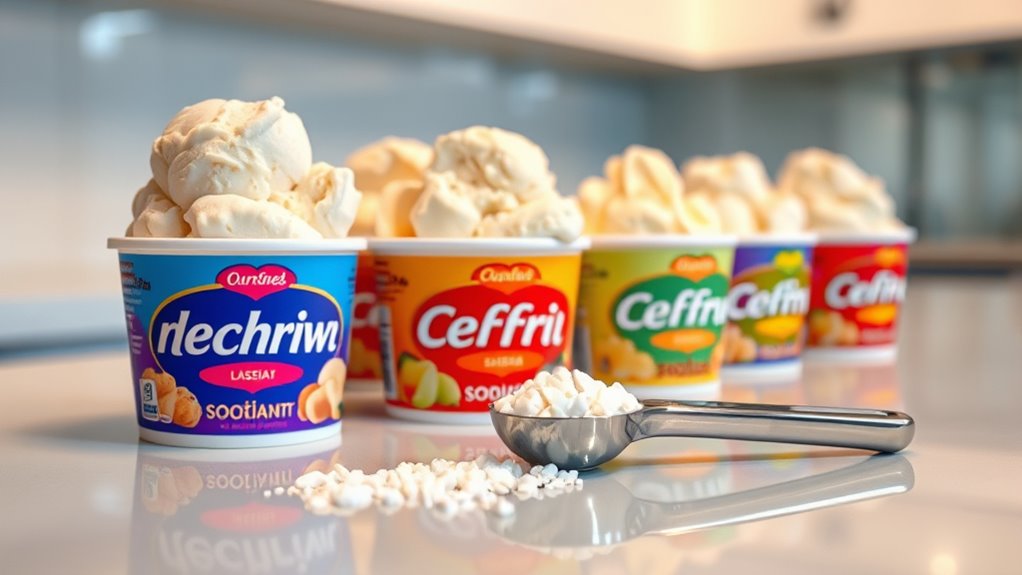
While browsing the ice cream aisle, you might notice that sodium levels can vary greatly between brands. Typically, sodium levels range from 50 mg to over 69 mg per 1/2 cup serving.
Premium brands often have higher sodium levels due to added ingredients, while lighter or no-sugar-added varieties usually contain less. Flavor plays a crucial role, too; for instance, salted caramel flavors might pack more sodium than classic vanilla.
Premium ice creams often contain more sodium due to added ingredients, while lighter options typically have less. Flavor can also impact sodium levels significantly.
On average, you can expect around 69.60 mg of sodium per 1-cup serving, but this depends on the specific brand and formulation.
It’s important to check nutrition labels, as sodium levels can differ markedly even among similar ice cream types from various brands.
Tips for Choosing Low-Sodium Ice Cream

When you’re picking ice cream, always check the nutrition labels for sodium content.
Look for options with natural flavors, as they often have less sodium than processed varieties.
This way, you can enjoy your treat while keeping your sodium intake in check.
Check Nutrition Labels
How can you enjoy ice cream without worrying about sodium intake? The key is to check nutrition labels carefully. When you do, look for sodium levels; a typical 1/2 cup serving contains around 50 to 60 mg.
Aim for options with less than 50 mg to keep your sodium in check. Remember, the Daily Value (DV) tells you how much sodium contributes to your daily intake, guiding your choices.
- Savor every scoop without guilt!
- Discover delicious low-sodium treats.
- Keep your health in balance while enjoying life.
Be cautious with premium brands; they often have sodium levels exceeding 70 mg per serving.
Always compare serving sizes, as larger portions can greatly increase your total sodium intake.
Opt for Natural Flavors
Choosing ice cream with natural flavors not only enhances your taste experience but also helps you keep sodium levels in check.
Natural flavors typically contain lower sodium compared to their artificially flavored counterparts, making them a smarter choice for your health. When you’re checking nutrition labels, aim for options with sodium levels lower than the typical 50 mg per 1/2 cup serving.
Some brands even offer low-sodium ice creams specifically designed for those mindful of their dietary intake. If you’re feeling adventurous, try making homemade ice cream, allowing you full control over the ingredients and sodium content.
Remember to stick to 1/2 cup servings, as larger portions can quickly increase your overall sodium intake. Enjoy your treat responsibly!
Homemade Ice Cream: A Healthier Alternative
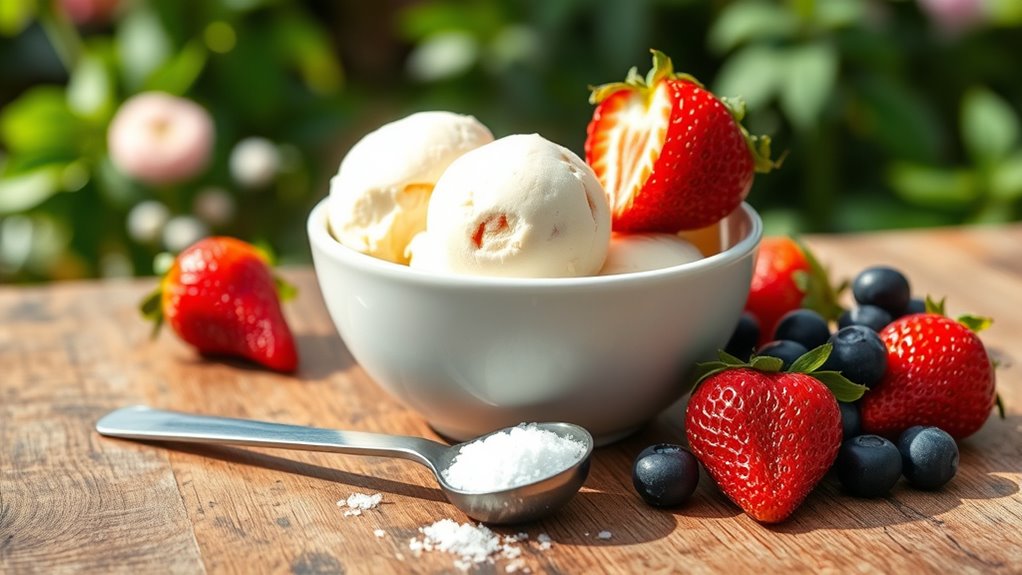
Making homemade ice cream not only lets you indulge in a delicious treat but also gives you full control over its nutritional content. By choosing low-sodium ingredients, you can greatly reduce the sodium content compared to store-bought options. Plus, with fresh fruits and natural flavorings, you can create a delightful dessert with minimal added sodium.
- Savor the rich flavors of fresh ingredients.
- Enjoy guilt-free indulgence tailored to your needs.
- Create memories with loved ones while making your treat. Making your own ice cream allows you to incorporate various flavors that can elevate your dessert experience. Additionally, incorporating mineral-based options can further enhance the health benefits of your homemade ice cream.
You can also adjust the sugar and fat content, making your ice cream a source of beneficial nutrients like calcium and vitamin A. Additionally, using churned perfection in your ice cream maker ensures a smooth and creamy consistency that enhances your homemade creation.
Homemade ice cream truly offers a healthier alternative that satisfies your cravings and supports your well-being.
Frequently Asked Questions
Can You Eat Ice Cream if You Have High Blood Pressure?
Yes, you can enjoy ice cream if you have high blood pressure, but moderation’s key.
Make sure you’re mindful of your overall sodium intake and choose low-sodium options when possible.
It’s important to balance your treats with a healthy diet and monitor other factors like calories and sugar.
Consulting with your healthcare provider can help you find a way to indulge while managing your condition effectively.
Enjoy your treat wisely!
How Much Sodium Is in a Bowl of Ice Cream?
When you think of a bowl of ice cream, you might picture a delightful treat, but you should also consider its sodium content.
Depending on the brand and flavor, a standard serving can pack around 50 to 57.6 mg of sodium. If you go for a full bowl, that number can double!
Does Soft Serve Ice Cream Have a Lot of Sodium?
You might be surprised to learn that soft serve ice cream does contain some sodium. Depending on the recipe and brand, a typical serving can have around 100-140 mg of sodium.
While it’s not excessively high, it’s still worth noting if you’re watching your sodium intake. If you enjoy various flavors and toppings, the sodium content can increase.
What Foods Are High in Sodium to Avoid?
You wouldn’t believe the sodium lurking in everyday foods!
To keep your intake in check, steer clear of processed meats like bacon and deli slices, which can pack over 1,000 mg per serving.
Canned soups often hide around 800 mg per cup, while snack foods like chips and pretzels might surprise you with 300 mg per serving.
Frozen meals can skyrocket past 1,500 mg, so watch what you eat!
Conclusion
In choosing ice cream, remember that not all treats are created equal. By comparing sodium levels, reading labels, and opting for low-sodium options, you can enjoy your favorite dessert without compromising your health. Whether you buy from the store or whip up a homemade version, you can savor the sweetness, delight in the creaminess, and embrace a healthier lifestyle. So, indulge wisely, choose smartly, and enjoy your ice cream guilt-free!
